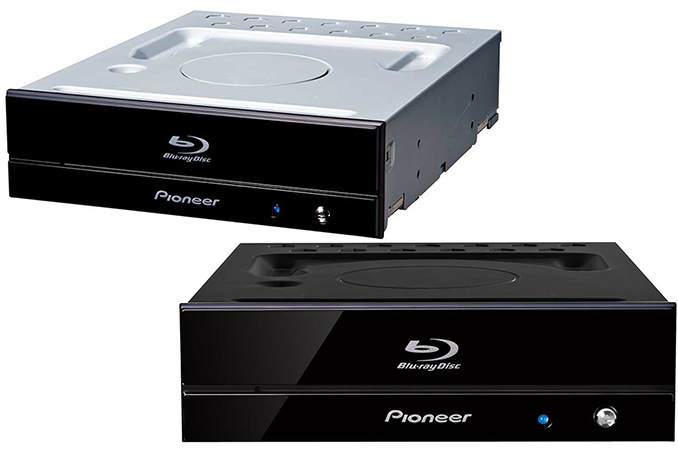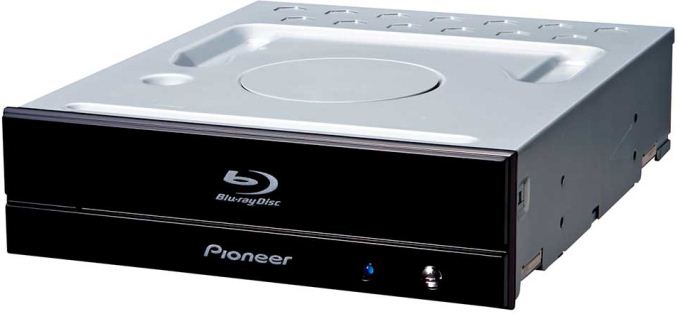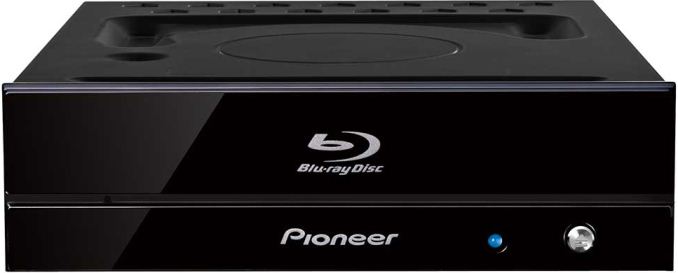Pioneer Announces Ultra HD Blu-ray Supporting BDR-S11J Drives
by Anton Shilov on January 26, 2017 4:25 AM EST- Posted in
- Optical Media
- 4K
- UHD
- ODDs
- Pioneer
- Ultra HD Blu-ray

Pioneer has announced its first Blu-ray disc burners that officially support playback of Ultra HD Blu-ray discs. The drives will be Pioneer’s top-of-the-range ODDs and will thus support all the latest technologies from the company, but it is important to note that Ultra HD Blu-ray discs have a number of specific requirements and despite formal support for the latest media format, the drives will not transform any PC into a UHD BD player alone due to the numerous requirements (something that system integrators will have to ensure).
The New Drives
The Pioneer BDR-S11J-BK and the BDR-S11J-X are advanced optical disc drives in a 5.25” form-factor with the SATA 3.0 interface capable of reading and recording CD (CD, CD-R, CD-RW), DVD (DVD, DVD±R, DVD±R DL, DVD±RW, DVD-RAM) and Blu-ray (BD, BD-R SL/DL/TL/QL, BD-RE SL/DL/TL, BD-R LTH) discs. The drives have 4 MB buffer underrun protection (which is in line with other higher-end ODDs from competitors) and support 16x burning speed for BD-R SL (25 GB) media. Meanwhile, writing capabilities are not the key feature of the new ODDs. Pioneer advertises improved CD audio playback as well as support for Ultra HD Blu-ray discs as the key selling points of the new drives by way of updated technologies.
Usage of optical discs has been declining in the recent years, but those people who still use ODDs tend to demand features like fine reading/playback of scratched discs in general and audio CDs in particular (simply because they have large collections of appropriate media). To appeal to these people, the Pioneer BDR-S11J-BK and the BDR-S11J-X support the PureRead 4+ and Real Time PureRead functions specifically tailored to improve reading performance of scratched audio CDs. In addition, the more expensive BDR-S11J-X has further enhancements to improve playback quality of inserted audio CDs. Pioneer does not reveal too many details other than saying about finely tuned internal components (possibly to minimize vibration) as well as a feature called the “playback quality check.”
Another important capability of the Pioneer BDR-S11J-BK and the BDR-S11J-X ODDs is guaranteed support for Ultra HD Blu-ray discs. Technically speaking, to read a 100 GB Ultra HD Blu-ray disc, an ODD must support triple-layer Blu-ray disc with 33 GB layers and up to 128 Mbps data rate (i.e., 4x read speed). Therefore, any BDXL-supporting BD ODD has technical capabilities to read UHD BDs. However, not everything is that simple.
New Requirements for Ultra HD Blu-ray Video Playback
Meanwhile, to actually playback an Ultra HD Blu-ray disc, users will need:
- A PC that supports AACS 2.0 and Intel Software Guard Extensions (SGX)
- An appropriate optical disk drive,
- Software that handles UHD BD playback,
- Windows 10,
- A GPU that has an HDMI 2.0a output with HDCP 2.2 (and AACS2 supported by its driver, which eliminates current-gen standalone GPUs) and,
- A 4K TV/display that has an HDMI 2.0a input with HDCP 2.2.
While there are graphics adapters that support HDCP 2.2, as well as displays that also support it, at the time of writing there are no software packages that support playback of Ultra HD Blu-ray discs. CyberLink last year promised to update its PowerDVD 16 Ultra to support UHD BDs, but so far, this feature has not been formally added to the player. Now, while many contemporary BDXL-supporting ODDs can read Ultra HD Blu-ray discs (and allow users to browse files or write to them), manufacturers tend not to declare UHD BD playback support by their products. While it is possible that this is a software limitation, it is also possible that the limitation is hardware and currently available optical drives miss an important piece or two required to playback UHD BD movies even once appropriate software is available and they are installed into qualifying PCs. That said, Pioneer is currently the only ODD supplier that formally declares support for UHD BDs, at least in terms of files.
Apart from the ODD, the GPU (and its driver), the display, and the playback software, AACS 2.0 support seems to be a major concern. Its implementation on the PC is different from other consumer electronics, according to CyberLink. In a bid not to let AACS 2.0 encryption keys leak (as it happened in the past to the original AACS), AACS LA demands to handle their decryption in a secure hardware environment. To create secured private regions of memory that cannot be accessed by third-party applications (to prevent access to AACS2 keys), software developers have to use Intel’s Software Guard Extensions (SGX) instructions, whereas end users have to use platforms featuring the technology. Intel’s SGX has to be supported by the CPU, the OS and the application, but one of the problems is that not all modern processors support it. Intel first incorporated SGX into its Skylake CPUs in 2015, but not all of such chips support the tech: for example, some of the early higher-end processors have it disabled. Moreover, SGX has to be supported by motherboard’s BIOS and at present Pioneer recommends Intel 200-series based platforms (note that this does not mean that every Intel 200-series mainboard supports SGX). It is also important to note that not every Intel 200-series motherboard/system supports HDCP 2.2, which is required if the integrated is used. In fact, in the latter case Pioneer says that Intel’s HD Graphics 630 or more advanced is required, which eliminates low-power CPUs.
One of the peculiarities of playback via AACS2 is that it has to be supported by the whole system, not just certain critical components. This may not be a big problem for consumer electronics (even though it has its peculiarities there as well, for example, a requirement to pair a drive with its host that binds them at time of manufacture that will make lives of people who rip disks harder, but will also make it impossible to replace a failed ODD in a player), but for PCs things are going to get considerably more complicated. The content has to be encrypted using AACS2 throughout the whole data transfer from the optical disc to the decoder (i.e., the GPU for a PC) and then decoded in a secure environment. Since AACS2 mandates the use of secure environment at all times, decryption of Ultra HD Blu-ray content in a PC is now possible only on an iGPU that uses system memory with appropriate regions set aside for this particular task. Unless companies like AMD and NVIDIA invent their own SGX-like technology or manage to support Intel’s extensions in their drivers and by their discrete hardware, it will not be possible to use standalone GPUs for Ultra HD Blu-ray playback despite all their advanced media decoding capabilities. Quite naturally, this leaves systems based on Intel’s multi-core Core i7 HEDT processors without Ultra HD Blu-ray encoded playback content, but that is a price that PCs have to pay for AACS2.
Pioneer will bundle various programs with the BDR-S11J-BK and the BDR-S11J-X ODDs, including CyberLink’s PowerDVD 14 (not quite new), PowerDirector 14, PowerProducer 5.5, Power 2 Go 8, InstantBurn 5 and so on. The manufacturer did not reveal the official price of the new drives, but PC Watch reports that the BDR-S11J-BK and BDR-S11J-X will be priced at ¥22,000 ($193) and ¥35,000 yen ($307) respectively when they are available in Japan in late February.













64 Comments
View All Comments
Bullwinkle J Moose - Friday, January 27, 2017 - link
"if you can just break the 1000 year media don't you... lose data?"----------------------------------------------------------------------------------
No, I lose malware!
Any data I want to keep is malware-free and burned to a new disk before the old one is broken
I don't use M-Disks for general crap that might contain malware
I break the cheap stuff, and I have never used a 4.7GB M-disks
I'm not worried about my antivirus being disable on a Read Only Operating System either
If I let it connect to the Internet or pick one that takes over the firewall, then I might worry, but I'm not finding any malware that can wreck my XP install
The only malware I've had doing damage in the past year was on a fully updated, fresh install of Windows 8.1 even though I only research and look for malware with XP, not 8.1
So those man in the middle attacks and network screengrabs in 8.1 must have been of the NSA variety huh?
close - Friday, January 27, 2017 - link
So you break the disk, kill the malware, and keep the data? Oh wait, that was the backup of your 1-2-5-7 year old data that you just discovered has malware and nothing can clean it. Too bad for your data. Now it's gone along with the malware and you have no other backup. And since you had that malware 1-2-5-7 years ago it's safe to assume everything on your computer and every backup since then is infected. You not only lost all your backups but all the current data in your computer. Damn man, you're a real menace :).If you ever want to learn how to properly back up data without using media designed for gullible, uneducated consumers willing to spend more without an actual benefit let me know. I'll teach you some tricks that will blow your... um... mind.
Dunno what you mean about screengrabs in 8.1. Do you have a dude behind you taking pics of the stuff on your screen or what?
Bullwinkle J Moose - Friday, January 27, 2017 - link
Not even CLOSEContinually trying to find problems where none exist is the hallmark of your Trolling expertise
But at least your jokes are funny!
YOU are going to teach ME tricks?
Bwaaahahahahhahahhahah
close - Saturday, January 28, 2017 - link
I don't do tricks, I write the book for everyone to follow. Tricks are for pets... and cartoons :).First you claim to buy into buzz-word tech like M-Disc with 0 proven benefits (and have to pay a hefty premium for it at every step). To be honest I don't believe you ever saw an M-Disc in person, you even spell it wrong. Then you tentatively admit you have no idea how to properly use read/write media (magnetic/flash) to back up data. Then you try to find a way to explain how you recover lost data from an infected backup by... BREAKING THE DISK TO DESTROY THE MALWARE.
You lose your main data. You try to recover it from the backup on the expensive wonder-disk from the teleshopping channel. You discover the disk is full of malware. You break the disk to kill the malware. Now you have no main data. You also have no backup. Data is gone forever. You try to sound cool. Your scenarios don't make sense and aren't even funny.
Now you've been called a troll by almost everybody around here but I honestly don't agree with them. Throwing paper airplanes doesn't make you a pilot. Running in the back yard doesn't make you Usain Bolt. At least my jokes are funny.
There was a time when trolling was funny and creative. Now the internet is full of people like you: no creativity, no ingenuity, no spontaneity, no sense of humor, just endless repetition of material that was bad from the get go and only gets worse the more you repeat it. Ugh...
Bullwinkle J Moose - Saturday, January 28, 2017 - link
OMG OMG OMGI spellt it rong
and he called me a TROLL !
Where-O-where are the censors when you really need them?
Gich - Thursday, January 26, 2017 - link
This is about watching UHD BR movies on PC.Not about personal videos or backups.
Bullwinkle J Moose - Thursday, January 26, 2017 - link
"This is about watching UHD BR movies on PC."---------------------------------------------------------------
That's Cool....
Got any Non-DRM Nightmare gadgets that I can watch UHD BR movies on PC when I'm not burning backups?
Bullwinkle J Moose - Thursday, January 26, 2017 - link
sorry....BD-RE is equivalent to DVD+RW as they are both rewritable data disks
DVD+R is not rewritable
DVD-R is for video recorders / not data disk and is usually non-bootable in computers except for the few rare boot schemes that work with that format
It would be nice to carry 4 or 5 bootable Acronis drive backups in a shirt pocket though
Bullwinkle J Moose - Thursday, January 26, 2017 - link
and Please don't confuse rewritable disks with READ ONLY data!If I burn and close a rewritable optical disk, it is READ ONLY until I erase the entire disk and burn a new one
B&H photo still sells the 1.4GB sony DVD+RW mini disks
They make Great recovery boot disks
Gothmoth - Thursday, January 26, 2017 - link
who the hell will buy such a drive for 300$ ???i rather buy an -box and enjoy a few games in addition.
PC makers shoot themself in the foot with such stuff.
it´s not as if PC sales roar.
the day aacs 2 is cracked (and it will be) many people will say "i am not buying that crap i download rips". and hollywood will sell no UHD blu rays at all to them.